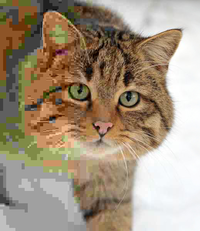
Back جيه بيه إي جي Arabic JPEG AST JPEG Azerbaijani JPEG Byelorussian JPEG Bulgarian জেপিইজি Bengali/Bangla JPEG BS JPEG Catalan JPEG Czech JPEG Danish
 | |
 A photo of a European wildcat with the compression rate, and associated losses, decreasing from left to right | |
| Filename extension | .jpg, .jpeg, .jpe.jif, .jfif, .jfi |
|---|---|
| Internet media type |
image/jpeg |
| Type code | JPEG |
| Uniform Type Identifier (UTI) | public.jpeg |
| Magic number | ff d8 ff |
| Developed by | Joint Photographic Experts Group, IBM, Mitsubishi Electric, AT&T, Canon Inc.[1] |
| Initial release | September 18, 1992 |
| Type of format | Lossy image compression format |
| Extended to | JPEG 2000 |
| Standard | ISO/IEC 10918, ITU-T T.81, ITU-T T.83, ITU-T T.84, ITU-T T.86 |
| Website | jpeg |
JPEG (/ˈdʒeɪpɛɡ/ JAY-peg, short for Joint Photographic Experts Group)[2] is a commonly used method of lossy compression for digital images, particularly for those images produced by digital photography. The degree of compression can be adjusted, allowing a selectable tradeoff between storage size and image quality. JPEG typically achieves 10:1 compression with little perceptible loss in image quality.[3] Since its introduction in 1992, JPEG has been the most widely used image compression standard in the world,[4][5] and the most widely used digital image format, with several billion JPEG images produced every day as of 2015.[6]
The Joint Photographic Experts Group created the standard in 1992.[7] JPEG was largely responsible for the proliferation of digital images and digital photos across the Internet and later social media.[8][circular reference] JPEG compression is used in a number of image file formats. JPEG/Exif is the most common image format used by digital cameras and other photographic image capture devices; along with JPEG/JFIF, it is the most common format for storing and transmitting photographic images on the World Wide Web.[9] These format variations are often not distinguished and are simply called JPEG.
The MIME media type for JPEG is "image/jpeg", except in older Internet Explorer versions, which provide a MIME type of "image/pjpeg" when uploading JPEG images.[10] JPEG files usually have a filename extension of "jpg" or "jpeg". JPEG/JFIF supports a maximum image size of 65,535×65,535 pixels,[11] hence up to 4 gigapixels for an aspect ratio of 1:1. In 2000, the JPEG group introduced a format intended to be a successor, JPEG 2000, but it was unable to replace the original JPEG as the dominant image standard.[12]
- ^ Cite error: The named reference
t81was invoked but never defined (see the help page). - ^ "Definition of "JPEG"". Collins English Dictionary. Archived from the original on 21 September 2013. Retrieved 23 May 2013.
- ^ Haines, Richard F.; Chuang, Sherry L. (1 July 1992). The effects of video compression on acceptability of images for monitoring life sciences experiments (Technical report). NASA. NASA-TP-3239, A-92040, NAS 1.60:3239. Retrieved 13 March 2016.
The JPEG still-image-compression levels, even with the large range of 5:1 to 120:1 in this study, yielded equally high levels of acceptability
- ^ Cite error: The named reference
Hudsonwas invoked but never defined (see the help page). - ^ Svetlik, Joe (31 May 2018). "The JPEG Image Format Explained". BT.com. BT Group. Archived from the original on 5 August 2019. Retrieved 5 August 2019.
- ^ Baraniuk, Chris (15 October 2015). "Copy Protections Could Come to JPEGs". BBC News. BBC. Archived from the original on 9 October 2019. Retrieved 13 September 2019.
- ^ Trinkwalder, Andrea (7 October 2016). "JPEG: 25 Jahre und kein bisschen alt" [JPEG: 25 years (old) and not a bit old]. de:Heise online (in German). Archived from the original on 5 September 2019. Retrieved 5 September 2019.
- ^ Caplan, Paul (24 September 2013). "What Is a JPEG? The Invisible Object You See Every Day". The Atlantic. Archived from the original on 9 October 2019. Retrieved 13 September 2019.
- ^ "HTTP Archive – Interesting Stats". httparchive.org. Retrieved 6 April 2016.
- ^ "MIME Type Detection in Internet Explorer". Microsoft. 13 July 2016. Archived from the original on 30 October 2022. Retrieved 2 November 2022.
- ^ "JPEG File Interchange Format" (PDF). 3 September 2014. Archived from the original on 3 September 2014. Retrieved 16 October 2017.
{{cite web}}: CS1 maint: bot: original URL status unknown (link) - ^ "Why JPEG 2000 Never Took Off". American National Standards Institute. 10 July 2018. Archived from the original on 16 December 2018. Retrieved 13 September 2019.
© MMXXIII Rich X Search. We shall prevail. All rights reserved. Rich X Search